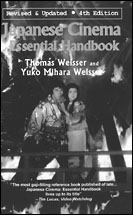Japanese Cinema: Essential Handbook
by Jasper Sharp
Those familiar with the author's previous forays into the world of Hong Kong Cinema and Spaghetti Westerns will know pretty much what to expect here, and it falls far short of any dictionary definition of "essential". Short, cursory capsule reviews, short on insight, style, and cultural context and high on typographical and factual errors, accompanied by an arbitrary star rating from one to four. The main virtue of Weisser's self-published book is its rigorously completist approach. Even though it states that it is not the aim to include every single film from Japan ever released, with separate editions available for a more complete look at Horror, Science Fiction and Fantasy, and Sex Films, and one planned for animation ("pleae check our subsiquent books" [sic], Weisser writes in the intro for the fourth edition), this initial volume certainly covers a lot of films and does give quite a good indication as to how much is actually out there.
However, though claims are made at covering a wide-ranging sample of Japanese cinema, from "high art" to "gutter trash", Weisser's own criterion for selection would appear to tip the balance heavily towards the latter, as the likes of Ozu and Mizoguchi are given short shrift in comparison to such titles as Uniform Girls: The Fruit is Ripe and High Heeled Punishers - not quite as representative as the book's title might suggest. There's certainly no mention of some of the more influential directors from the last decade such as Hirozaku Kore-eda (After Life, Maborosi) or Nobuhiro Suwa (2/Duo and M/Other).
Weisser's approach to film criticism favours gung-ho enthusiasm (and an excessively tedious use of italics and CAPITAL LETTERS to make his POINT!!!!!) over perceptive evaluation, with ludicrous claims such as that Koji Wakamatsu's Erotic Liaisons (1992) is "a near perfect film" whilst Teinosuke Kinugasa's "indiscernible direction and archaic techniques spoil this particularly strong tale" in the Cannes winning 1953 film Gate of Hell. Indeed, Weisser seems to have somewhat of a bee in his bonnet regarding his own cinematic tastes, constant railing against "art house audiences" and "serious film critics", yet at the same time offering little support for his own opinions.
Critical comment and interpretation is of course the prerogative of any reviewer. Sypnopses however are not, and it is clear in a number of cases that Weisser has not seen a good percent of the films under review. This would be forgivable given the large selection of titles under review were it not for a tendency to pass judgement on the particular films in question. Masato Harada's Bounce KoGals (1997), for example, is described as "a fashionable sex movie, sort of like the Spice Girl's Spiceworld times 10." Titles are listed under their Japanese translated titles rather than original release titles, resulting in such confusing anomalies as the first Lone Wolf film, Child and Expertise for Rent - released outside Japan originally as Sword of Vengeance - being indexed under Lone Wolf: Lend a Child, Lend an Arm.
It's not all bad however. The book sports an impressive array of glossy stills, and whilst it is easy to mock Weisser's anti-intellectual approach, it is worth stressing once more that throughout his entire cycle of encyclopediae he does cover a lot of films that have never been written about before in English. Personally I doubt Donald Richie has seen Female Ninja Chronicles, Death Powder, or any of the Guinea Pig series, so whilst The Essential Handbook is limited in terms of its use as a reference guide, and sorely skewed in its focus towards the less high-brow end of the market, it undeniably covers a lot of ground left untrodden by other writers.
